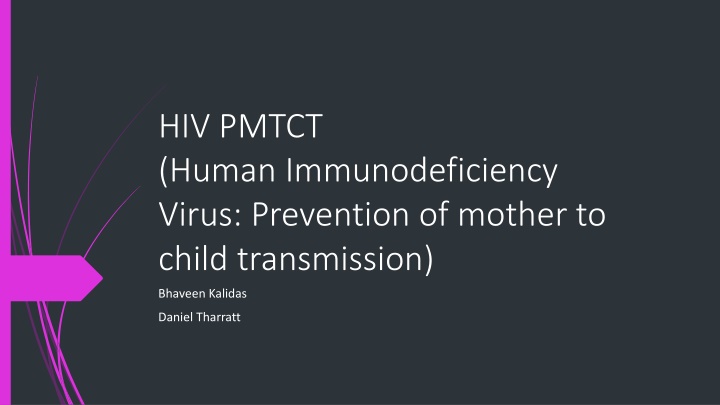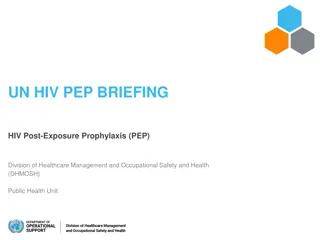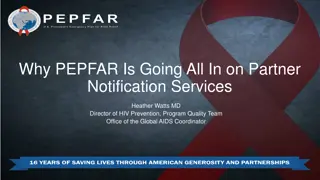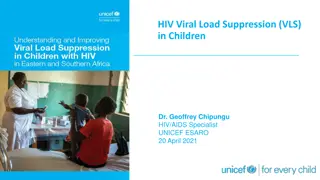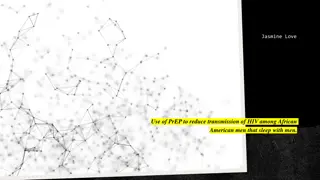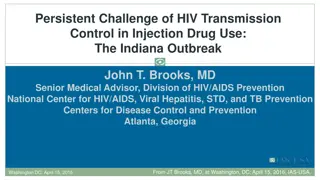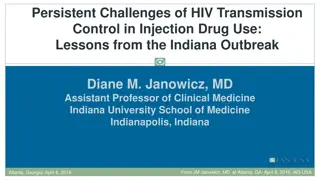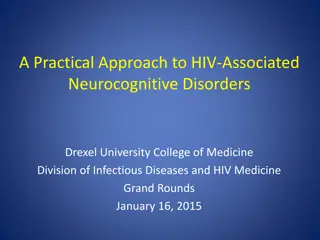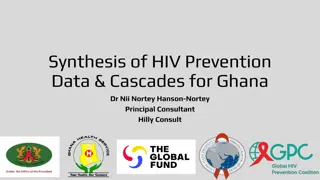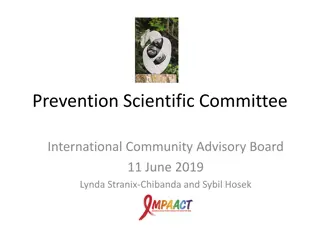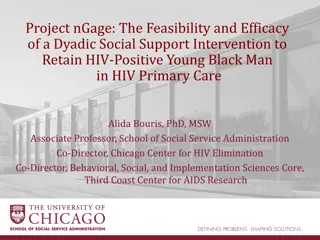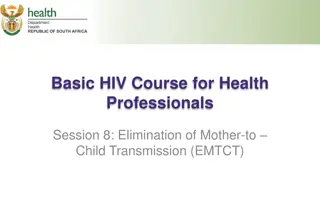Preventing Mother-to-Child Transmission of HIV: Strategies and Challenges
The prevention of mother-to-child transmission (PMTCT) of HIV is crucial to reduce perinatal morbidity and mortality. South Africa faces challenges in tackling this issue, including the rising rates of other transmittable diseases. The four pillars for prevention focus on primary prevention, family care, and appropriate treatment. The ANC guidelines emphasize HIV testing, counseling, and linkage to care for HIV-positive mothers and their children.
Uploaded on Sep 22, 2024 | 6 Views
Download Presentation

Please find below an Image/Link to download the presentation.
The content on the website is provided AS IS for your information and personal use only. It may not be sold, licensed, or shared on other websites without obtaining consent from the author.If you encounter any issues during the download, it is possible that the publisher has removed the file from their server.
You are allowed to download the files provided on this website for personal or commercial use, subject to the condition that they are used lawfully. All files are the property of their respective owners.
The content on the website is provided AS IS for your information and personal use only. It may not be sold, licensed, or shared on other websites without obtaining consent from the author.
E N D
Presentation Transcript
HIV PMTCT (Human Immunodeficiency Virus: Prevention of mother to child transmission ) Bhaveen Kalidas Daniel Tharratt
Introduction Vertical transmission Vast majority of infections Perinatal morbidity and mortality. PMTCT What does it entail? Statistics: 15% to 45% without treatment Can reduce this risk to below 5%. EMTCT and WHO Syphillis South African Guidelines HIV, Hepatitis, Listeriosis, Malaria, Syphilis and TB
South Africa The Challenges Option B+ (lifelong ART irrespective of CD4 count or WHO staging) Birth PCR Monitoring of the infant PCR test positive around 10 weeks rate indicated a reduction in the MTCT rate from 1.3% in the FY 2016/17 to 0.9% in the FY 2017/18. Rise of other transmittable diseases 2014 2016 TB was responsible for 9% of all maternal deaths, Hepatitis contributed 1.1% and malaria 1.7%. 2017 Increase in syphilis amongst pregnant woman to 2% Outbreak of Listeriosis The challenge that PMTCT is currently facing is an increasing number of babies who acquire HIV infection during the postnatal period. - Ms MP Matsoso
South Africa Tackling the Problem ANC Dolutegravir-based ART regimen. Integrating PMTCT BANC visits during antenatal period EPI visits during postnatal period.
The Four Pillars for Prevention of Transmittable Infections from Mother to Child 1. Primary prevention of transmittable diseases, especially among women of childbearing age 2. Preventing unintended pregnancies among women diagnosed with transmittable infections 3. Preventing disease transmission from a woman living with a transmittable disease to her infant 4. Providing appropriate treatment, care, and support to women, their children, partners and families
Summary of Changes in the 2019 PMTCT Guidelines
ANC: Testing for HIV HIV Testing: Provider Initiated Counselling and Testing (PICT) should be provided to all women with unknown or HIV-negative status: Offer an HIV test at ANC first/booking visit. Retest the HIV-negative mother at every routine BANC Plus visit. Offer couple/partner testing to promote prevention, access to HIV care and treatment, and/or manage discordant results (when one partner is HIV-positive and the other partner HIV- negative). If the woman and/or her partner test HIV-negative, provide HIV prevention information Women who choose not to be tested should be offered post-refusal counselling and offered a re-test at every subsequent visit. If a woman tests HIV-positive at any stage, encourage testing of her other children, and linkage to HIV care and treatment as necessary.
ANC: Treatment for HIV Pregnant women already on ART should continue their current ART regimen pending their 1st VL result Only if her VL is <50 c/ml, and she is no longer in the 1st six weeks, offer her the option of switching to DTG (If her VL is 50 c/ml, manage her as per the VL Non-suppression algorithm All newly diagnosed HIV-positive pregnant women are eligible for lifelong ART regardless of gestation, CD4 count, or clinical stage. Creatinine and CD4 count should still be done to determine renal function and the need for prophylaxis (TB, PCP and CM). TDF, 3TC, and DTG (as a fixed dose combination) is the preferred regimen for women who are newly initiating ART. Known HIV positive women, who are not currently on ART, but are ART-exposed (e.g. previous PMTCT) should initiate a DTG-containing regimen. Documented VL that was suppressed while she was previously on ART, start TLD. If no VL result is available, or her VL was not suppressed, start AZT, 3TC, and DTG. All women living with HIV should be referred to a CHW to support adherence, breastfeeding and retention in care pre- and post-delivery.
ANC: Viral Load Monitoring and Management Key points: Newly diagnosed and initiated ART for the first time: Do 1st VL at 3 months on ART. If VL < 50 c/ml, repeat VL at delivery. Known HIV-positive women already on ART: VL at first/booking visit in ANC, If VL < 50 c/ml, repeat VL at delivery. Known HIV-positive women, who are not currently on ART, but are ART exposed (e.g. previous PMTCT) and who are initiating a DTG-containing regimen: Do 1st VL at 3 months on ART. If VL < 50 c/ml, repeat VL at delivery. If the VL is 50 c/ml in any of the above scenarios, go to the VL Non-suppression Algorithm
Labour and Delivery ARVs: Testing for HIV: VL Monitoring and Management: Pregnant women already on ART should continue their current ART regimen at usual dosing times during labour. PICT should be provided to all women presenting in labour ward who are not known to be HIV- positive (including born-before-arrivals [BBAs]): Check if the mother has had a VL result in the last 12 weeks and categorize the risk for the infant: VL < 1000c/ml = Low risk VL 1000 c/ml = High risk No VL result in the last 12 weeks = High risk All women must have a VL test done at the time of delivery. Newly diagnosed, or known HIV positive women not on ART: Give a stat single fixed dose combination tablet of TDF, 3TC and DTG (TLD) and a stat single dose of NVP. Lifelong ART should be initiated the following day after contra-indications to ART have been excluded . TLD is the preferred regimen, provided the mother has been provided with all necessary information on DTG and EFV- based regimens including the risk of NTDs. A contraceptive method is recommended. Provide her with a choice of contraceptive options as desired. Appropriate ART literacy education. Mothers must understand and anticipate the adherence challenges that may be experienced in the postpartum period. Offer couples counselling and partner testing. Post Refusal counselling and offered a re- test at every subsequent visit. If a woman tests positive at any stage, encourage testing of her other children, and linkage to HIV care and treatment as necessary. Barcode sticker in postnatal discharge form and the RTHB. If a woman has indeterminate or discrepant HIV test results, treat the baby as a high risk HIV-exposed infant until mother s HIV status can be confirmed. Communicate clearly to the mother and document the results and plan of action in the maternal record and RTHB. The results of the delivery VL must be checked at the 3-6-day postnatal visit, and the management of the mother- infant pair adjusted accordingly.
Care of the HIV-Exposed Infant at Delivery All HIV-exposed Infants should receive a birth HIV-PCR to identify HIV transmission that occurred in-utero. All HIV-exposed Infants should receive a minimum of six weeks post exposure prophylaxis with NVP. Identify the high-risk infants for whom additional prophylaxis must be provided: Mother with a VL of 1000 c/ml at delivery (or most recent VL taken during the last 12 weeks of antenatal care), or Mother with no VL result in the last 12 weeks. These infants should be provided with high-risk prophylaxis until the result of the delivery-VL can be checked at the 3-6-day postnatal visit. When the delivery-VL result is known, the infant can be re-classified as high/ low-risk and prophylaxis adjusted accordingly. All high-risk infants who are breastfed should receive additional AZT for the first six weeks of life and should receive NVP for a minimum of 12 weeks. NVP should only be stopped when the breastfeeding mother has a VL of less than 1000 c/ml, or until four weeks after she has stopped breastfeeding. All high risk infants who are exclusively formula fed should receive AZT for 6 weeks and NVP for 6 weeks. Provide oral polio vaccine, BCG and other routine neonatal care as per the Maternity Care and Neonatal Care Guidelines. Do not give BCG if baby is TB-exposed, and will be receiving TB prophylaxis
Care of the Mother after Birth 6 days 6 weeks 10 weeks 6 months 18 months Testing for HIV Retest the HIV-negative mother if she was not retested in labour Retest every HIV-negative mother at the 10-week visit (-three months postpartum), the six- month visit, and every three months whilst breastfeeding. Remember to offer partner testing. If no longer breastfeeding, ensure that the mother receives an HIV test at least every year ARVs Mother to continue ART during the postpartum period and for life. If she is newly diagnosed during the breastfeeding period, initiate ART after contra-indications to ART have been excluded. Provide appropriate counselling on available ART options. TDF, 3TC, and DTG (TLD) is the preferred regimen, provided the mother has been given all necessary information on DTG and EFV-based regimens including the risk of NTDs. This is a high-risk period for poor adherence. Ensure that the mother understands the importance of continued viral suppression for her own health and that of her baby. She must also understand and anticipate the adherence challenges that may be experienced in the postpartum period. Link the mother to mom- connect, a CHW, a mentor mother, or a support group/club if available. Whether continued ART care is provided at MNCWH services (preferred) or at PHC/Wellness services, ensure that mother is retained in care, adherent to ART, and maintains a suppressed viral load. VL Monitoring and Management Check ART adherence Follow-up on result of delivery-VL. (If not yet available, follow-up again in 1 week. If VL not done at delivery, do VL at this visit) If VL 50 c/ml: manage mother as per VL Nonsuppression Algorithm. If VL 1000 c/ml: manage infant as a high-risk infant i.e. add AZT for six weeks, and extend NVP until mother s VL is <1000 c/ml. Check ART adherence. Repeat VL if delivery-VL was 1000 c/ml. Check mother s ART supply and confirm where she will be receiving her ongoing ART care. Check ART adherence. Check, record and act on any earlier VL tests. Check mother s ART supply and confirm where she will be receiving her ongoing ART care. Check ART adherence at every visit. Check, record and act on results of any earlier VL tests. Do a VL for all HIV-positive mothers on ART at six months. Continue VL monitoring every six months (at 12,18, and 24 months) whilst breastfeeding. Ensure that the results of any VL test are checked within 1 week. If VL 50c/ml: Recall the mother-infant pair to the facility Manage mother as per VL Nonsuppression Algorithm If VL 1000 c/ml: Restart/extend infant prophylaxis if mother is still breastfeeding.
Care of the HIV-exposed Infant after Birth 3-6 days 6 weeks 10 weeks 6 months 18 months Other tests (at any time) HIV Testing and Early Infant Diagnosis Follow-up results of birth PCR and manage accordingly. Any HIV positive neonate should be discussed/referred to a clinician experienced in managing an HIV positive neonate. ART should be initiated even if the infants weighs less than 2,5kg. Ensure that birth + PCR and mother s VL results were checked, recorded and acted upon correctly. HIV-PCR for all HIV- exposed infants who previously tested HIV-PCR negative. Known HIV-exposed infants: Do HIV-PCR test at 6 months in all HIV-exposed infants, except in those who previously tested positive and are on ART. Infants not known to be HIV-exposed: At six months of age, establish the HIV status of all infants not already known to be HIV-exposed Offer an HIV test to the mother. If she tests HIV negative, no infant test is required If the mother is not available, or refuses an HIV test, get consent and do an HIV rapid test on the infant All positive infant rapid tests need to be confirmed with an HIV- PCR. Universal HIV testing at 18 months (HIV rapid test for ALL infants regardless of HIV exposure, except in those who previously tested HIV positive and are on ART) Do an age appropriate HIV test 6 weeks post cessation of breastfeeding, even if breastfeeding continues beyond 18 months of age. Test a symptomatic child at any age according to IMCI guideline. Confirmatory Test for HIV Any child under two years with a positive HIV-PCR or a positive HIV rapid test should have their HIV status confirmed with a HIV-PCR test on a new sample. At the clinician s discretion, the HIV-PCR may be replaced by a viral load test which has the advantage of both confirming the HIV diagnosis and providing a baseline VL for monitoring the child s response to ART. Any child who tests HIV positive should initiate ART according to the Paediatric ART guideline as a matter of urgency. Do not wait for the confirmatory result before initiating ART but ensure that this result is checked. For the Management of Indeterminate HIV PCR results, go to page 25. Infant Prophylaxis Check adherence/tolerance to NVP (and AZT, if applicable). Ask the mother to explain how she administers the infant s medication. Check result of mother s delivery-VL. If necessary re-classify infant as high/ low-risk and adjust prophylaxis accordingly. All HEI s: Start Cotrimoxazole prophylaxis therapy (CPT), even if birth PCR was negative. Low-risk infant: Stop NVP if mother s VL at delivery was <1000 c/ml. High-risk infants: stop AZT, continue NVP for a minimum of 12 weeks, or until four weeks after all breastfeeding has stopped High-risk infants: Continue NVP prophylaxis. Ask mother to return at 12 weeks to evaluate VL result and stop/extend NVP as necessary At every visit, check results of mother s most recent VL. An elevated VL may require high-risk infant prophylaxis (6 weeks AZT twice daily and 12 weeks NVP daily) to be restarted or existing NVP prophylaxis to be extended. NB: NVP dose adjustment according to weight Stop NVP after 12 weeks only if mother s VL is < 1000 c/ml. If the maternal VL is not suppressed by 12 weeks, continued NVP until mother s VL is <1000 c/ml, or until four weeks after all breastfeeding has stopped. Continue cotrimoxazole prophylaxis until infant is confirmed HIV negative six weeks post cessation of breastfeeding. For formula fed infants, CPT may be stopped if the infant is confirmed to be HIV negative at the 10-weeks PCR test, provided that no breastfeeding has occurred in the six weeks prior to the 10-week PCR test. If a child tests HIV positive at any stage, stop NVP prophylaxis, initiate ART, do a confirmatory HIV PCR, and continue cotrimoxazole prophylaxis according to guidelines.
Prophylaxis of the HIV- Exposed Infant
Viral Load Non- Suppression Algorithm (NSA)
Breastfeeding HIV or HIV-uninfected, recommendations for Infant feeding remain the same HIV VL suppression in mother is essential to prevent MTCT through breastfeeding! For all women, exclusive breastfeeding (EBF) is recommended for the 1st six months of life. Thereafter, breastfeeding should continue for two years or longer, with the introduction of nutritionally adequate, appropriate and safe complementary feeding. Women living with HIV should be fully supported for ART adherence during the breastfeeding period and thereafter. WHO Statements: Any mother that is mixed feeding in the first 6 months should be encouraged to return to exclusive breastfeeding. However, mothers living with HIV and health-care workers can be reassured that ART reduces the risk of postnatal HIV transmission in the context of mixed feeding. Although exclusive breastfeeding is recommended, practicing mixed feeding with formula milk is not a reason to stop breastfeeding in the presence of ARV drugs. Mothers living with HIV and health-care workers can be reassured that shorter durations of breastfeeding of less than 12 months are better than never initiating breastfeeding at all.
Conclusion Good progress Current challenges and the way forward Post natal infection Rise of other transmittable infections Path to elimination
References 1. Communicable Infections. [online] Available at: <https://www.knowledgehub.org.za/system/files/elibdownloads/2020-05/PMTCT%20Guideline%2003- 2020%20PRINT%20v8.pdf> [Accessed 6 March 2021]. Knowledgehub.org.za. 2021. Guideline for the Prevention of Mother to Child Transmission of 2. <https://www.avert.org/professionals/hiv-programming/prevention/prevention-mother-child> [Accessed 9 March 2021]. Avert. 2021. Prevention of mother-to-child transmission (PMTCT) of HIV. [online] Available at: 3. <https://www.avert.org/professionals/hiv-programming/prevention/prevention-mother- child#:~:text=Prevention%20of%20mother%2Dto%2Dchild%20transmission%20(PMTCT)%20programmes,th roughout%20pregnancy%2C%20labour%20and%20breastfeeding.> [Accessed 9 March 2021]. Avert. 2021. Prevention of mother-to-child transmission (PMTCT) of HIV. [online] Available at: 4. Available at: <https://www.who.int/gho/hiv/epidemic_response/PMTCT/en/> [Accessed 9 March 2021]. World Health Organization. 2021. Prevention of mother-to-child transmission (PMTCT). [online]
